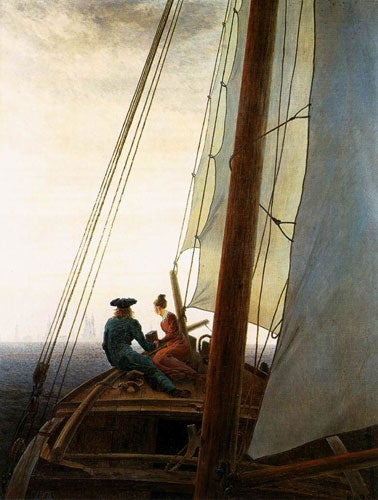On The Sailing Boat (1819), By Caspar David Friedrich

A picture is a view. A view implies a viewer. A viewer is a self in the world. So a picture, through its view, may not only show us a scene from the world. It can show us how a self experiences the world.
Caspar David Friedrich's On the Sailing Boat is a scene with two figures in it. A man and a woman, hand in hand, sit on the prow of a yacht. They face away from us, looking out across the water, across some river or sea, towards a farther shore where lies the edge of a city, their destination. It's a horizon of gothic spires, glowing, misty, barely visible. It's some non-specific over there place – a dream-land, another world. They're on a soul's journey.
We see this couple in the middle of an active voyage. Their boat leans over on the water. The mast swings across. The sail bellies out and flaps, the rigging strains, the loops tug. The dramatic asymmetry of the composition stresses the irregular conditions of their course, caught as they are in the turbulence and contingencies of nature.
And the viewer is caught up with them. This isn't a scene that you can stand back from and survey. It's a view that involves you. The boat itself is the immediate foreground, seen close up. It goes out of the frame, cut off at the picture's edges. You're looking through its mast, boom, sail and tackle. This is a subjective shot – like a view through a bush or a keyhole. Visually, you're in the thick of it.
On the Sailing Boat shows you an experience of the world. You're given a particular viewpoint – and with that comes a particular standpoint, too. Somebody looking so close up through this boat's framework must be aboard it. You're not a stationary or grounded viewer. You're afloat on water yourself, rolling sideways and moving forwards.
In other words, you're urged to identify with the couple on the prow. They're your proxies or projections. They look the same way as you look. You're on board with them, on the same water and the same journey, travelling towards the same mysterious yonder. Looking at this picture, like them, you're cast as a self at sea in the world. But there is another dimension to your experience.
On the Sailing Boat has a calculated composition. At one level, the scene is thrown to the right, and cut off by the edges, and unstable. At another level, it has a firmly fixed structure. See how the shape of the yacht's prow is set within the frame. It stands symmetrical and centred. It makes itself the form of an upright gothic arch. The point of this arch touches exactly the line of the horizontal of the shore.
Through this underlying design, this geometrical "subtext", the scene is righted, levelled, directed. The picture is held, pointed ahead. The view is filled with purpose. You may be on a swaying journey, but through it you're being taken onwards, on your way, aimed straight towards your goal.
It's a twofold experience that Friedrich offers to his viewer. You're striving in the midst of contingency – and also under the sure guidance of destiny. The couple may not know this, but you and the picture know.
About the artistCaspar David Friedrich (1774-1840) is the great painter of loss and longing. He painted Romantic landscapes – ruins, forests, mountains, oceans, nights. He said: "Close your bodily eye, so that you may see your picture first with your spiritual eye; then bring to the light of day that which you have seen in darkness, so that it may react on others from the outside inwards." He composes scenes in mystic symmetry. He obscures things in mist or distance. He puts a mute element bang in the middle – a back-turned figure, a rugged cross. And the imagination rushes in.
Join our commenting forum
Join thought-provoking conversations, follow other Independent readers and see their replies
Comments